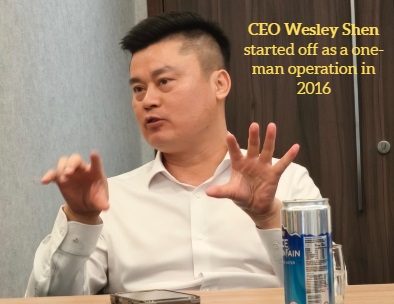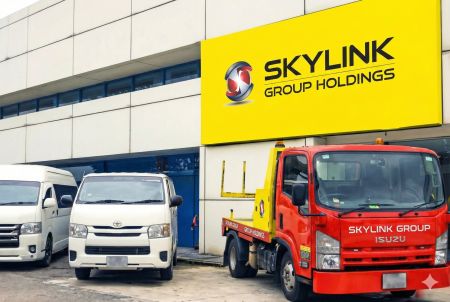| Skylink Holdings has a steady vehicle leasing business backed by hard assets, plus clear growth drivers in its credit and engineering arms. These give it a mix of stability and strong growth potential when conditions are favourable. The company, which has just completed a reverse takeover (RTO) of Sincap Group in Sept 2025 on Catalist, is one of the top 5 in the commercial vehicle leasing space in Singapore. It raised about $9.2 million in gross proceeds via placement shares and convertible bonds.  Remarkably, the CEO and founder, Wesley Shen, started the company by buying and selling commercial vehicles, and then rapidly grew it into a diversified leasing, financing and engineering business. In the near-term, watch out for Skylink's effort to grow fast via mergers and acquisitions. |
The Business Model: Three Pillars, One Ecosystem
Skylink is a fully integrated operation built on three segments:
- Commercial Vehicle Leasing: Skylink's fleet ranks among the top five largest commercial vehicle fleets in Singapore.
It focuses on B2B clients, leasing out light-duty, mini vans, and various trucks.
This segment is crucial because leasing creates predictable, recurring income.
- Skylink Credit: Need a loan to buy a commercial vehicle?
Skylink provides higher-purchase financing, drawing on bank facilities.
Currently, the active loan book stands at a substantial $66 million.
While the vehicle leasing business generates the largest revenue, the credit business has the highest return on investment. - Engineering Solution: This segment provides Maintenance, Repair, and Overhaul (MRO) services for all types of commercial vehicles.
It even offers customization services for vehicle upper body structures like lorry decks and canopies.
While it has been mainly servicing its own leased fleet, it recently ventured out to seek big third-party business, successfully landing two-year contracts with SBS Transit and F&N Foods.
By setting up its own MRO in 2019, Skylink gained control over costs and turnaround time, which is essential for a large fleet.
These three segments form an ecosystem, where leasing, credit and engineering reinforce each other and supporthigh gross margins, as the table shows:
|
STRONG MARGINS |
||
|
Segment |
1HFY26 |
Gross margin |
|
Engineering |
2.00 |
50.7% |
|
Credit |
1.66 |
51.7% |
|
Commercial vehicle leasing |
12.48 |
15.9% |
|
Total |
16.14 |
|
Source: 1HFY26 results Growth Trajectories: From 10 to 1,200 Vehicles
Growth Trajectories: From 10 to 1,200 Vehicles
Skylink's journey is a textbook case of spectacular success.
The company started small with commercial vehicle trading in 2017.
- The Pivot: In 2018, as falling COE prices increased vehicle trading risks, it diversified into commercial vehicle leasing, starting with only about 10 vehicles, and launched the credit business.
- The Pandemic Opportunity: When the pandemic struck in 2020, the business—supporting logistics and transportation—was deemed essential.
The leasing fleet expanded from 130 vehicles at the start of 2020 to approximately 580 vehicles by 2021. - Strategic Cash-Out and Consolidation: In a bold move during 2022-2023, the company strategically disposed of about 350 vehicles.
 Teh Wing Kwan, non-executive chairman, holds a 15% stake in Skylink whose RTO he had orchestrated.This generated a massive $8 million cash which, alongside new banking facilities, provided the funding base for acquisitions.
Teh Wing Kwan, non-executive chairman, holds a 15% stake in Skylink whose RTO he had orchestrated.This generated a massive $8 million cash which, alongside new banking facilities, provided the funding base for acquisitions. - Accelerated Growth: Skylink went on to acquire three leasing companies, boosting the fleet back up to about 900 vehicles.
The fleet grew to 1,200 vehicles by March 2025. - Engineering Expansion: This segment is also scaling up, expanding its operational footprint to over 30,000 sq ft across two locations to support new contracts.
This expansion is expected to be a significant profit driver.
When you look under the hood, Skylink shows strong fundamentals:
|
|||||||||||||
In a nutshell, Skylink Holdings has quickly evolved from a vehicle trader into a sophisticated, vertically integrated player.
It has recurring revenue pillars, a sizeable fleet for leasing, and a M&A hunger, which is perhaps why its stock has gone from 22.5 cents (the price at which shares were issued to acquire Skylink during the RTO) to ~30 cents since. → For more, see the Skylink Powerpoint deck here.
→ For more, see the Skylink Powerpoint deck here.

